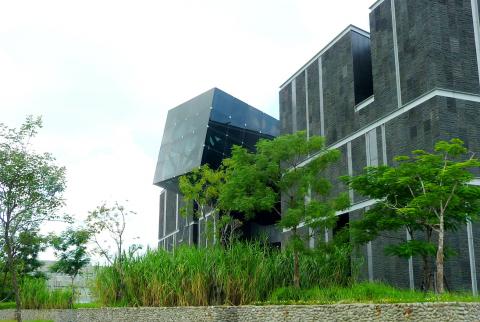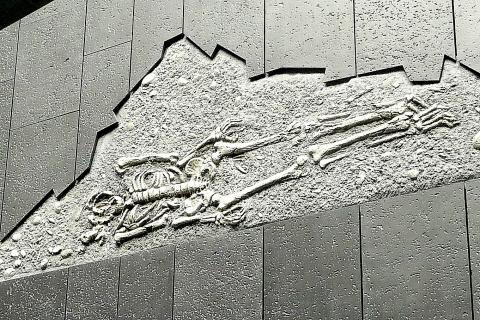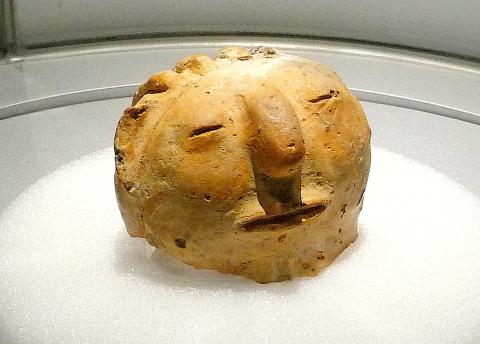For archaeologists, the development of the Tainan section of the Southern Taiwan Science Park (南部科學工業園區) turned out to be an unexpected bonanza. Before the high-tech industrial park was established a quarter of a century ago, much of its land belonged to Taiwan Sugar Corporation (台糖). As cane plantations were converted into wafer fabs, 58 sites of archaeological interest were unearthed, and some startling discoveries were made.
The thoroughness with which archaeologists surveyed the science park is in part the result of local politics. News that building the park could endanger heritage sites emboldened opponents of the plan, while unsuccessful candidate locations used it as ammunition when lobbying the central government to reconsider their choice. What began as a government-sponsored six-month evaluation snowballed into a long-term effort to rescue what would otherwise be destroyed by diggers or sealed beneath concrete.
More than 65,000 people now work in the 1,043-hectare park, which sprawls across parts of the Tainan City districts of Anding (安定), Shanhua (善化), and Sinshih (新市). Nowadays, few people live within its boundaries. However, prehistoric human settlers left behind more than 2,000 graves, countless tools and weapons, as well as garbage heaps that tell us something about their diet.

Photo: Steven Crook
Biofacts (organic material found at an archaeological site, as opposed to artifacts, which are objects made by humans) retrieved at the science park’s Nankuanli East (南關里東) site prove beyond doubt that Taiwanese grew rice long before the arrival of Han settlers in the 17th century — a finding that surprises both Han and indigenous Taiwanese. Archaeologisists also recovered domesticated and wild millet, fish bones and the remains of boar, deer, hares and muntjac. Some canine bones show signs of cutting (meaning those animals were probably eaten), but other dogs were buried intact, suggesting they were valued as hunting companions.
Nankuanli East is associated with the Tapenkeng culture (大坌坑文化), the earliest of Taiwan’s Neolithic cultures, and radiocarbon dating indicates people lived there approximately 4,300 to 5,000 years ago. Other sites in the park have given up traces of the more recent Niuchoutzu (牛稠子), Tahu (大湖), Niaosong (蔦松), Siraya (西拉雅), and Han cultures.
Several hundred of the approximately eight million items recovered from digs around the science park are now on display in the Museum of Archaeology, Tainan Branch of the National Museum of Prehistory (國立臺灣史前文化博物館南科考古館). The museum soft-opened at the end of last year, and there’s no admission charge for the two exhibition halls currently open to the public. Another two halls will be ready on October 19. From that date, the museum will open Tuesday to Sunday instead of Monday to Friday.

Photo: Steven Crook
I visited the museum earlier this summer, and found it so worthwhile that I’m determined to go back after Oct. 19. Museum staff told me the new exhibitions will focus on the scientific methods of archaeology and the lives of Taiwanese ancestors, but that no final decision has been made about admission charges.
The tour direction begins by introducing the area’s geographical history. Until around 5,000 years ago, much of what’s now the science park was beneath the sea. The coastline moved westward due to tectonic activity and sediment deposited by rivers to the north and south. Nankuanli East had a twofold attraction to early humans: It was both higher than other points of land, and thus less prone to inundation, yet conveniently close to the ocean and the food that could be harvested from it.
Some educated guesswork has gone into the miniature dioramas which depict life in prehistoric settlements. At local pre-Han sites, the only evidence of dwellings found so far are small holes perhaps left by bamboo columns. Accordingly, the dioramas feature huts like those indigenous people are known to have assembled using bamboo, wood and thatch.

Photo: Steven Crook
With the exception of two mockup graves (one human, one canine), almost everything in the display cases was found in the vicinity of the museum. Several items are thrillingly ancient. Others aren’t quite so old. They’re just — for want of a better word — exceptionally “cool.”
Among the detritus left behind by the Siraya community at Shenei (社內) are four dice made of deer antler, a material that ethnic group also turned into knife handles. The sides of each die are marked with between one and six dots, just like the dice that have been used for thousands of years across the rest of Asia and Europe.
It’s not known if the Siraya learned about dice from Han people, or from the Dutch who occupied Tainan for part of the 17th century. Another find from Shenei almost certainly came from Europeans. The porcelain figurine is incomplete and smaller than a thumb drive, yet grips what could be a telescope, and wears a tricorn hat, just like a Western sailor of that era.

Photo: Steven Crook
Before visiting the museum, I had never seen urns which served as coffins. Two from the Niuchoutzu phase (3,300 to 3,800 years ago), found broken into dozens of pieces at the Yousianfang (右先方) site and reassembled, are displayed. According to Peter Bellwood’s First Islanders: Prehistory and Human Migration in Island Southeast Asia (2017), these burial jars are “the oldest evidence for this tradition in Island Southeast Asia by perhaps a millennium.”
Other ceramic items include net sinkers (for fishing), medicine pots, and porcelain plates and bowls that were made in Japan and Vietnam. There are arrowheads, axes, chisels, knives and hammers fashioned from stone. Bone relics include a perforated human mandible possibly used for decorative or ritual purposes.
Visitors can get a good look at one of the science park’s most photographed treasures: a globular human face made of clay and found at the Niaosong era site at Daoye (道爺). This primal work of art is more than 1,000 years old, and it’s one of a number from that site which display “a rather mature level of craftsmanship… distinctive traits of the bridge of the nose and the eyebrow ridge, as well as the placement of the eye sockets and nostrils” (Archaelogical Heritage in the Tainan Science Park of Taiwan by Cheng-hwa Tsang (臧振華) and Kuang-ti Li (李匡悌), published by the National Museum of Prehistory).
At the end of my visit, I walked around the outside of the museum to better appreciate architect Kris Yao’s (姚仁喜) design. The building has received silver-level certification from EEWH (Taiwan’s official sustainable-architecture rating system, akin to LEED in the US), despite being covered with black basalt imported from China.
This choice of material baffles me. In terms of albedo (the percentage of total solar radiation received by a surface that it reflects rather than absorbs), it could hardly be worse. Just before midday on a summer’s day, I touched the basalt in several places. Cloudy sky notwithstanding, it was very warm.
The building collects and reuses rainwater, but — despite the government’s push for renewables — there’s not a single photovoltaic panel on the roof. Thinking about this later, I realized there’s one question which this otherwise excellent museum doesn’t answer: How many of these cultures collapsed amid catastrophe, and how often was it their own fault?
Steven Crook has been writing about travel, culture, and business in Taiwan since 1996. He is the co-author of A Culinary History of Taipei: Beyond Pork and Ponlai, and author of Taiwan: The Bradt Travel Guide, the third edition of which has just been published.

Most heroes are remembered for the battles they fought. Taiwan’s Black Bat Squadron is remembered for flying into Chinese airspace 838 times between 1953 and 1967, and for the 148 men whose sacrifice bought the intelligence that kept Taiwan secure. Two-thirds of the squadron died carrying out missions most people wouldn’t learn about for another 40 years. The squadron lost 15 aircraft and 148 crew members over those 14 years, making it the deadliest unit in Taiwan’s military history by casualty rate. They flew at night, often at low altitudes, straight into some of the most heavily defended airspace in Asia.

Taiwan’s democracy is at risk. Be very alarmed. This is not a drill. The current constitutional crisis progressed slowly, then suddenly. Political tensions, partisan hostility and emotions are all running high right when cool heads and calm negotiation are most needed. Oxford defines brinkmanship as: “The art or practice of pursuing a dangerous policy to the limits of safety before stopping, especially in politics.” It says the term comes from a quote from a 1956 Cold War interview with then-American Secretary of State John Foster Dulles, when he said: ‘The ability to get to the verge without getting into the war is

Beijing’s ironic, abusive tantrums aimed at Japan since Japanese Prime Minister Sanae Takaichi publicly stated that a Taiwan contingency would be an existential crisis for Japan, have revealed for all the world to see that the People’s Republic of China (PRC) lusts after Okinawa. We all owe Takaichi a debt of thanks for getting the PRC to make that public. The PRC and its netizens, taking their cue from the Chinese Communist Party (CCP), are presenting Okinawa by mirroring the claims about Taiwan. Official PRC propaganda organs began to wax lyrical about Okinawa’s “unsettled status” beginning last month. A Global

Like much in the world today, theater has experienced major disruptions over the six years since COVID-19. The pandemic, the war in Ukraine and social media have created a new normal of geopolitical and information uncertainty, and the performing arts are not immune to these effects. “Ten years ago people wanted to come to the theater to engage with important issues, but now the Internet allows them to engage with those issues powerfully and immediately,” said Faith Tan, programming director of the Esplanade in Singapore, speaking last week in Japan. “One reaction to unpredictability has been a renewed emphasis on